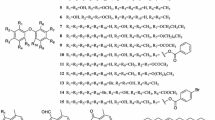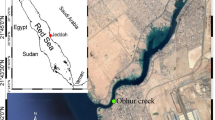Abstract
Marine biofouling has a major economic impact, especially when it occurs on ship hulls or aquaculture facilities. Since the International Maritime Organization (IMO) treaty to ban the application of organotin-based paints to ships went into effect in 2008, there is an urgent demand for the development of efficient and environmentally friendly antifouling agents. Marine microorganisms have proved to be a potential source of antifouling natural compounds. In this study, six dihydroquinolin-2-one-containing alkaloids, three monoterpenoids combined with a 4-phenyl-3,4-dihydroquinolin-2(1H)-one (1–3) and three 4-phenyl-3,4-dihydroquinolin-2(1H)-one alkaloids (4–6), were isolated from the gorgonian coral-derived fungus Scopulariopsis sp. collected in the South China Sea. These dihydroquinolin-2-one-containing alkaloids were evaluated against the larval settlement of barnacle Balanus amphitrite, and antifouling activity was detected for the first time for this class of metabolites. All of them except 6 showed strong antifouling activity. Compounds 1 and 2 were discovered to be the most promising non-toxic antilarval settlement candidates. Especially, compound 1 is the strongest antifouling compound in nature until now which showed highly potent activity with picomolar level (EC50 17.5 pM) and a very safety and high therapeutic ratio (LC50/EC50 1200). This represents an effective non-toxic, anti-larval settlement structural class of promising antifouling lead compound.


Similar content being viewed by others
References
An CY, Li XM, Luo H, Li CS, Wang MH, Xu GM, Wang BG (2013) 4-Phenyl-3,4-dihydroquinolone derivatives from Aspergillus nidulans MA-143, an endophytic fungus isolated from the mangrove plant Rhizophora stylosa. J Nat Prod 76:1896–1901
Blunt JW, Copp BR, Keyzers RA, Munroa MHG, Prinsep MR (2014) Marine natural products. Nat Prod Rep 31:160–258
Callow JA, Callow ME (2011) Trends in the development of environmentally friendly fouling-resistant marine coatings. Nat Commun 2:244–253
Clare AS (1996) Marine natural product antifoulants: status and potential. Biofouling 9:211–229
Clare AS, Rittschof D, Gerhart DJ, Hooper IR, Bonaventura J (1999) Antisettlement and narcotic action of analogues of diterpene marine natural product antifoulants from octocorals. Mar Biotechnol 1:427–436
Fernández-Alba AR, Hernando MD, Piedra L, Chisti Y (2002) Toxicity evaluation of single and mixed antifouling biocides measured with acute toxicity bioassays. Anal Chim Acta 456:303–312
Fusetani N (2004) Biofouling and antifouling. Nat Prod Rep 21:94–104
Fusetani N (2011) Antifouling marine natural products. Nat Prod Rep 28:400–410
Fusetani N, Clare A (2006) Antifouling compounds. Springer-Verlag, Berlin
Gardes M, Bruns TD (1993) ITS primer with enhanced specificity for basidiomycetes: application to the identification of mycorrhizae-and rusts. Mol Ecol 2:113–118
Gupta SP (2001) Quantitative structure–activity relationships of antianginal drugs. Prog Drug Res 56:121–154
Hall LW Jr, Gidding JM, Solomon KR, Balcomb R (1999) An ecological risk assessment for the use of Irgarol 1051 as an algaecide for antifouling paints. Crit Rev Toxicol 29:367–437
Harder TN, Thiyagarajan V, Qian PY (2001) Effect of cyprid age on the settlement of Balanus amphitrite darwin in response to natural biofilms. Biofouling 17:211–219
Head RM, Overbeke K, Klijnstra J, Biersteker R, Thomason JC (2003) The effect of gregariousness in cyprid settlement assays. Biofouling 19:269–278
Hellio C, Yebra D (eds) (2009) Advances in marine antifouling coatings and technologies. Woodhead Publishing Ltd., Cambridge
Holt JS (1993) Mechanisms and agronomic aspects of herbicide resistance. Annu Rev Plant Physiol Plant Mol Biol 44:203–229
Khandeparker L, Anil AC (2007) Underwater adhesion: the barnacle way. Int J Adhes Adhes 27:165–172
Kirschner CM, Brennan AB (2012) Atom probe tomography 2012. Annu Rev Mater Res 42:1–19
Kwong TFN, Miao L, Li X, Qian PY (2006) Novel antifouling and antimicrobial compound from a marine-derived fungus Ampelomyces sp. Mar Biotechnol 8:634–640
Lamoree MH, Swart CP, van der Horst A, van Hattum B (2002) Determination of Diuron and the antifouling paint biocide Irgarol 1051 in Dutch marinas and coastal waters. J Chromatogr 970:183–190
Li ZY, Liu Y (2006) Marine sponge Craniella austrialiensis associated bacterial diversity revelation based on 16S rDNA library and biologically active actinomycetes screening, phylogenetic analysis. Lett Appl Microbiol 43:410–416
Li YX, Wu HX, Xu Y, Shao CL, Wang CY, Qian PY (2013) Antifouling activity of secondary metabolites isolated from Chinese marine organisms. Mar Biotechnol 15:552–558
Meyer BN, Ferrigni NR, Putnam JE, Jacobson LB, Nicols DE, Mclaughlin JL (1982) Brine shrimp: a convenient general bioassay for active plant constituents. Planta Med 45:31–34
Muller WEG, Wang XH, Proksch P, Perry CC, Osinga R, Garderes J, Schroder HC (2013) Principles of biofouling protection in marine sponges: a model for the design of novel biomimetic and bioinspired coatings in the marine environment? Mar Biotechnol 15:375–398
Neff SA, Lee SU, Asami Y, Ahn JS, Oh H, Baltrusaitis J, Gloer JB, Wicklow DT (2012) Aflaquinolones A−G: secondary metabolites from marine and fungicolous isolates of Aspergillus spp. J Nat Prod 75:464–472
Newman DJ, Cragg GM (2012) Natural products as sources of new drugs over the 30 years from 1981 to 2010. J Nat Prod 75:311–335
Pierce CG, Uppuluri P, Teistan AR, Wormley JFL, Mowat E, Ramage G, Lopez-ribot JL (2008) A simple and reproducible 96-well plate-based method for the formation of fungal biofilms and its application to antifungal susceptibility testing. Nat Protoc 3:1494–1500
Qian PY, Xu Y, Fusetani N (2010) Natural products as antifouling compounds: recent progress and future perspectives. Biofouling 26:223–234
Ranke J, Jastorff B (2000) Multidimensional risk analysis of antifouling biocides. Environ Sci Pollut Res 7:109–110
Rao JV, Kavitha P, Jakka NM, Sridhar V, Usman PK (2007) Toxicity of organophosphates on morphology and locomotor behavior in brine shrimp, Artemia salina. Arch Environ Contam Toxicol 53:227–232
Rittschof D (1999) Fouling and natural products as antifoulants. In: Fingerman M, Nagabhushanam R, Thompson MF (eds) Recent advances in marine biotechnology, vol 3. Oxford & IBH Publishing Company, New Delhi, pp 245–257
Rittschof D (2001) Natural product antifoulants and coatings development. In: McClintock JB, Baker BJ (eds) Marine chemical ecology. CRC, Boca Raton, pp 543–566
Schultz M, Bendick J, Holm E, Hertel W (2011) Economic impact of biofouling on a naval surface ship. Biofouling 27:87–98
Scudiero DA, Shoemaker RH, Paull KD, Monks A, Tierney S, Nofziger TH, Currens MJ, Seniff D, Boyd MR (1988) Evaluation of a soluble tetrazolium/formazan assay for cell growth and drug sensitivity in culture using human and other tumor cell lines. Cancer Res 48:4827–4833
Shao CL, Wu HX, Wang CY, Liu QA, Xu Y, Wei MY, Qian PY, Gu YC, Zheng CJ, She ZG, Lin YC (2011) Potent antifouling resorcylic acid lactones from the gorgonian-derived fungus Cochliobolus lunatus. J Nat Prod 74:629–633
Shao CL, Xu RF, Wei MY, She ZG, Wang CY (2013) Structure and absolute configuration of fumiquinazoline L, an alkaloid from a gorgonian-derived Scopulariopsis sp. Fungus. J Nat Prod 76:779–782
Siddiqui AQ, Ballatore C, McGuigan C, De Clercq E, Balzarini J (1999) The presence of substituents on the aryl moiety of the aryl phosphoramidate derivative of d4T enhances anti-HIV efficacy in cell culture: a structure–activity relationship. J Med Chem 42:393–399
Solis PN, Wright CW, Anderson MM, Gupta MP, Phillipson JD (1993) A microwell cytotoxicity assay using Artemia salina (Brine Shrimp). Planta Med 59:250–252
Thiyagarajan V, Harder T, Qiu JW, Qian PY (2003) Energy content at metamorphosis and growth rate of the early juvenile barnacle Balanus amphitrite. Mar Biol 143:543–554
Thomas KV, McHugh M, Waldock M (2002) Antifouling paint booster biocides in UK coastal waters: input, occurrence and environmental fate. Sci Total Environ 293:117–127
White TJ, Bruns TD, Lee SB (1990) Amplification and direct sequencing of fungal ribosomal RNA genes for phylogenetics. In: Innis MA, Gelfand DH, Sninsky JJ, White TJ (eds) PCR protocols: a guide to methods and applications. Academic Press, New York, pp 315–322
Acknowledgments
We would like to thank Prof. Z.-G She and Y. Xu for their useful discussion. This work was supported by the Program of National Natural Science Foundation of China (Nos. 41322037, 41176121, and 41130858), and the Program for New Century Excellent Talents in University, Ministry of Education of China (No. NCET-11-0472).
Author information
Authors and Affiliations
Corresponding author
Rights and permissions
About this article
Cite this article
Shao, CL., Xu, RF., Wang, CY. et al. Potent Antifouling Marine Dihydroquinolin-2(1H)-one-Containing Alkaloids from the Gorgonian Coral-Derived Fungus Scopulariopsis sp.. Mar Biotechnol 17, 408–415 (2015). https://doi.org/10.1007/s10126-015-9628-x
Received:
Accepted:
Published:
Issue Date:
DOI: https://doi.org/10.1007/s10126-015-9628-x




